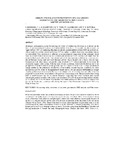| dc.contributor.author | Ringrose, S. | |
| dc.contributor.author | Kampunzu, A.B. | |
| dc.contributor.author | Vink, B.W. | |
| dc.contributor.author | Matheson, W. | |
| dc.contributor.author | Downey, W.S. | |
| dc.date.accessioned | 2009-04-28T10:43:18Z | |
| dc.date.available | 2009-04-28T10:43:18Z | |
| dc.date.issued | 2002 | |
| dc.identifier.citation | Ringrose, S. et al (2002) Origin and palaeo-environments of calcareous sediments' in the Moshaweng dry valley, Southeast Botswana, Earth Surface Processes and Landforms, Vol. 27, No. 6, pp. 591-611 | en |
| dc.identifier.issn | 0197-9337 | |
| dc.identifier.uri | http://hdl.handle.net/10311/310 | |
| dc.description.abstract | Quaternary sedimentation in the Moshaweng dry valley of southeastern Botswana is evaluated on the basis of geomorphological evolution and sedimentological analyses. Stratigraphic evidence reveals an 'upper surface (1095 m) containing abundant sil-calcrete, an intermediate surface (1085 m) in which sil-calcrete underlies nodular calcrete and lower (1075 m) surface in which sil-calcrete and nodular calcrete are interbedded. This subdivision is reflected in the geochemical composition of the sediments which show an overall trend of decreasing Si02 content (and increasing CaC03 content) with depth from the highest to the lowest surface levels. The calcretes and sil-calcretes represent modifications of pre-existing
detrital Kalahari Group sand and basal Kalahari pebbles which thinned over a Karoo bedrock high. Modification took place during wet periods when abundant Ca++ -rich groundwater flowed along the structurally aligned valley system. With the onset of drier conditions, water table fluctuations led to the precipitation of nodular calcretes in the phreatic layer to a depth of about 20 m. A major geochemical change resulted in the preferential silicification of the nodular calcrete deposits. Conditions for silica mobilization may be related to drying-induced salinity and in situ geochemical differentiation brought about by pebble dissociation towards the top of the sediment pile. As calcretization and valley formation progressed to lower levels, silica release took place on a diminishing scale. Thermoluminescence dating infers a mid-Pleistocene age for sil-calcrete formation suggesting that valley evolution and original calcrete precipitation are much older. Late st~ge dissolution of CaC03 from pre-existing surface calcretes or sil-calcretes led to the formation of pedogenic case-hardened deposits during a time of reduced flow through the Moshaweng system possibly during the upper or late Pleistocene. | en |
| dc.language.iso | en | en |
| dc.publisher | John Wiley & Sons, Ltd. http://www3.interscience.wiley.com/journal/117935722/grouphome/home.html | en |
| dc.subject | Moshaweng valley | en |
| dc.subject | Ca1cretes | en |
| dc.subject | Sil-ca1cretes | en |
| dc.subject | Geochemical-XRD analysis; | en |
| dc.subject | Mid-Pleistocene | en |
| dc.title | Origin and palaeo-environments of calcareous sediments' in the Moshaweng dry valley, Southeast Botswana | en |
| dc.type | Published Article | en |

